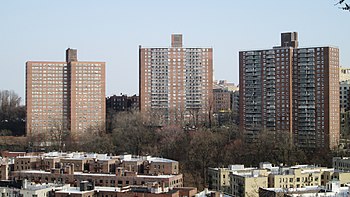Inwood, Manhattan
The north end of Manhattan, with its clam beds, cornfields, and annual fish runs, was described by the National Museum of the American Indian as the "best place to live" on the island before the Dutch and British colonists arrived in the 17th century.
A plaque (on a rock) marking what is believed to be the spot of the sale is in Inwood Hill Park, the only natural forest left in Manhattan.
[7] During the British occupation of Manhattan in the American Revolutionary War, there was an encampment containing more than sixty huts occupied by Hessian troops between 201st and 204th Streets along Payson Avenue.
Once the New York City Subway's IRT Broadway–Seventh Avenue Line, the modern 1 train, reached Inwood in 1906, speculative developers constructed numerous apartment buildings on the east side of Broadway.
[13] Based on data from the 2010 United States Census, the population of Inwood and Marble Hill was 46,746, a change of −2,341 (−5%) from the 49,087 counted in 2000.
It extends southward to Fort Tryon Park and alternatively Dyckman Street or Fairview Avenue farther south, depending on the source.
[23] Inwood marble, a soft, white, metamorphic rock found in northern Manhattan, takes its name after the neighborhood.
In recent years Dyckman Street west of Broadway has become a popular entertainment district with many restaurants and lounges.
Inwood also contains one of Manhattan's few remaining C-8 zoning districts, which concentrates automotive uses on the northern stretches of Broadway.
Most of the remaining detached and semi-detached houses on Manhattan Island are located in Inwood, nestled between apartment buildings.
"[19] The rezoning proposal has triggered much feedback from the community,[33] including a sleep-in at Councilman Ydanis Rodriguez's office.
[35][39] The New York Supreme Court initially ruled in favor of the plaintiffs in December 2019, but it was overturned on appeal in July 2020.
In part as a result of the lawsuit, the City Council passed a bill in June 2021, requiring developers to conduct a study of up to two years of potential displacement and gentrification trends and effects before starting a new project.
[40] Its tower dominates the skyline of the area and the museum can be easily accessed via steep pathways leading up from Dyckman Street.
[43][44] From Inwood Hill Park, one can view a 100-foot (30 m)-tall Columbia "C" painted on the face of a rock cut across the Harlem River on the Bronx shore.
This collegiate logo has been in place for approximately a half-century, though it is not clear who exactly maintains the painted letter in the present day.
[45] At the North Cove at 207th Street and the Harlem River, both the shoreline and the water just off it have been rehabilitated from their former derelict polluted state by James Cataldi (also known as the "Birdman of Inwood") into a flourishing wetland teeming with geese, ducks, and other varieties of fowl.
The wooded section, consisting mostly of abandoned former summer estates, features the last natural forest standing on Manhattan Island.
Tennis courts, three playgrounds, a waterfront promenade and ten miles of hiking trails are also prominent components of the park.
The football stadium within the complex, officially Robert K. Kraft Field at Lawrence A. Wien Stadium, can accommodate 17,000 fans and was noted by Sports Illustrated as "one of the most beautiful places in the country to watch a football game" due to the scenic views of the Henry Hudson Bridge and the New Jersey Palisades from the home stands.
This new structure now houses the Ivy League school's Crew team and hosts inter-collegiate rowing competitions.
[57] The Lt. William Tighe Triangle, aka the Riverside-Inwood Neighborhood Garden (RING), is the northernmost piece of Ft. Tryon Park and lies at the confluence of Riverside Drive, Dyckman Street, Broadway, and Seaman Avenue.
[62]: 205 [61] The newspaper features stories about news and events of interest to residents on the city and neighborhood level, and is funded in part by private advertisements in addition to public service announcements.
[17]: 14 The concentration of fine particulate matter, the deadliest type of air pollutant, in Community District 12 is 0.0078 milligrams per cubic metre (7.8×10−9 oz/cu ft), slightly greater than the city average of 0.0075.
[84] In the City Council, the neighborhood is part of the 10th district,[85] represented by Democrat Carmen De La Rosa.
[89] The Inwood Station, built in 1937 in Colonial Revival style, was listed on the National Register of Historic Places in 1989.
[90]: 10 [91] Community District 12 has fewer college graduates and more high school dropouts compared to the borough and city as a whole.
The Inwood branch was relocated to a temporary location across the street in 2020 for construction of a mixed-use complex on the site that combines affordable apartments with a new library facility in the base.
Technically, there is a ban on bicycles in Inwood Hill Park except for its western edge and the Henry Hudson Bridge.
The Broadway Bridge is undergoing a multi-year rehabilitation, which will include the addition of protected bike lanes north of 218th St to the Bronx.











